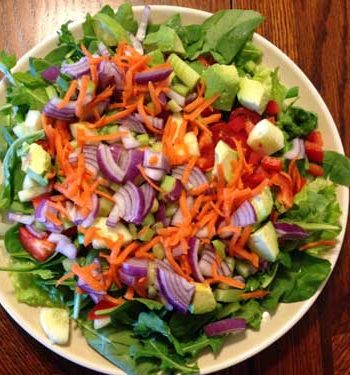This post contains affiliate links, which means I may earn some money if you click on one. Don't worry, there is no additional cost to you. Thank you for supporting my blog.
Eating healthy in this country is a challenge. (That is putting it mildly). There are a plethora of marketing ploys and labeling tricks that are DESIGNED to trick us into THINKING we are eating healthy. Many times we shop and eat for the convenience. Let’s face it, we live in a fast-paced, busy society. Most parents are working while raising a family, which makes it hard to spend a lot of time in the kitchen. We should be eating the way our grandparents did, our meals should be cooked from scratch with food, not “ingredients”. Real food does not have ingredients, real food IS the ingredients.
My family and I just came back from a long road trip, and the gluten-free scam is fresh on my mind.
When I say gluten-free scam, my intention is not to discard gluten sensitivities. My daughter and I eat mostly gluten-free. (We do occasionally consume sourdough, and Einkhorn flour products). I have sometimes fallen into the gluten-free trap myself. In fact, it happened this past weekend. I let my daughter eat some “gluten-free” pretzels in the car. (It was a LONG ride). I later looked at the ingredients in these “gluten-free” pretzels and I felt sort of nauseated. The ingredients were many and they were definitely not “natural”. Usually I am very careful, but this time I fell victim to the gluten-free scam.
Gluten-free does not mean healthy.
Yes, many of us are sensitive to gluten. But many of the “gluten-free” food items on the market are loaded with harmful ingredients. Food companies are also taking advantage of the “gluten-free” trend and labeling food as “gluten-free” even if it is not something that would typically contain gluten. I bought kimchi once that said “gluten-free” on the label. The ingredients in kimchi should be cabbage, salt, green onions, ginger, garlic, carrots, and red pepper powder or paste. Kimchi, if traditionally made, should not contain any gliadin.
I understand that some people are extremely sensitive to gluten, (celiacs, for example), and I am not trying to trivialize this sensitivity or the need for products to be accurately labeled. My contention is with these food companies taking advantage of people with food sensitivities.
It is not just gluten-free products, I see misleading labels everywhere. Non-GMO, and “natural” are labels that are often misleading as well.
One example is the non-GMO shake that is sold at local gas stations and Walmart. At first glance it looks like it could be a healthy fast-food option. (The label says GMO free and no sugar added). Sounds great, right? Apple puree and blueberry puree are listed in the top 3 ingredients. Apples and blueberries, if not organic, are heavily contaminated with pesticides. (source). Apples are in the top 5 on the heavy contamination list. This product label is very misleading because until recently, there were no GMO apples, bananas, or blueberries. (The GMO apple has been recently introduced to the grocery shelves). (source). Why does it say non-GMO? It is to trick you. They are not lying, it is marketing. So is this shake healthy because it says it is GMO free? I would think some of the benefits would be negated by the chemical contamination. The synthetic vitamins that have been added can cause problems for some people as well. When traveling, it is not difficult to make a smoothie yourself, freeze it, and pack it in these silicone smoothie containers. It just takes a little planning.
Now obviously a shake with fruit and vegetables is healthier than most of the fast food you will find at a gas station. I only used the above example to illustrate misleading marketing. GMO free is not the same as Organic.
The healthiest option I have found is “certified organic”. There are standards associated with this label, and if it is organic it has not been “transgenetically” modified. Some people have pointed out to me that some pesticides are allowed to be used on “organically grown” food. That is true, but at the moment, it is best option we have, at least commercially. (Growing our own food or buying from a farmer you know is the best option). If you must buy processed food, the less ingredients the better. (I bought rice cakes from Thrive Market for our trip. The only ingredient was brown rice and sea salt).
Next time you go food shopping, read the ingredients on the box/package label. Ask yourself if you know what the ingredients are. Count the ingredients. If there are more than a few ingredients, it is probably not healthy. If there are ingredients you cannot pronounce, it is probably not “natural”.
I find it disheartening that naturally minded people, like me, are ostracized or called names because of our food choices. The media says you have an eating disorder if you try to eat healthy. Why is it is pathological to want your apple to just be an apple? Is it unreasonable to want to give your children food without excitotoxins?
I want the food I eat to be healthy. If I put it in my mouth, or feed it to my kids, I want it to be something my body recognizes as food. If that makes me a rebel of sorts, than so be it. Will I mess up on occasion, yes. Am I perfect, no. But how ridiculous is it that we have to be vigilant simply to give our children NOURISHING FOOD without toxins and synthetic chemicals?
My hope is that more consumers will become informed and make changes in our food supply by voting with our dollars. If we wait for the FDA and the USDA to enforce any type of appropriate labeling, we will be waiting a very long time.
What has been your experience with deceptive marketing?





No Comments